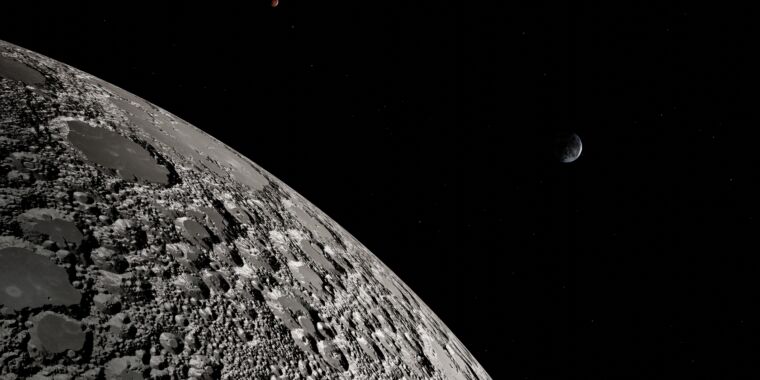But why?
I can’t really think of any scenario where this would be needed or practical.
Edit: other than for fortifying landing pads as mentioned in the article.
Eh? The whole article refers to lunar dust being the bane of existence there. The slabs would no longer be kicking up dust into sensitive delicate stuff.
What sensitive delicate stuff needs to be lugged around on roads on the moon a lot?
Everything would benefit not being exposed to moon dust, especially humans.
The moon dust is extremely sticky, abrasive, chemically reactive and terrible for the health.
And it’s not like we can just hose down the rover or the spacesuit to remove the dust. I think dealing with the moon dust can be one of the major hurdle of setting up a moonbase.
Believe it or not, the answer to your question is also in the article.
The first paragraph list another motivation:
mitigate damage from sharp particles of lunar regolith
Can only guess.
But if colonisation. Or even long term occupation for research. Is to happen. Then there will be need to house and maintain landers and launch veicles of some form.
Such will mean a need to move from launch pad to an enviroment where technician’s can repair test and maintain in shelter.
Yes launchpads I can see, and short stretches of fortified paths to and from those, but I find it highly unlikely that there will ever be the need to construct roads for overland travel on the moon.
Agreed. Only time I can see it being needed. Is if we end up with multiple nation colonies. Trade between them may be a reason.
But its far from clear.
But landing pads alone. Seems like a valid reason to consider the tech.
It may also lead to the production of movable regalth sheets. (Assuming structural integrity can be resolved. ) Used to build shelters.
I can see a future possible. Where people lay rebar like grids in the dust. Cover it. Satalite uses sunlight to power lasers to melt the dust. And that generates a sheet of ceramic material used for all lorts of production.
But why would we want to colonize the Moon?
Setting up a colony would be fantastically expensive, living there would be tough, the low gravity might cause health issues similar to what microgravity or weightlessness cause, and the colony would be completely reliant for resupplies from Earth which would also be very expensive.
Colonizing it “just 'cause” doesn’t seem like it’d make sense. Habitats for research might, but it’d be on a much smaller scale so it’s unclear whether roads would be needed.
Edit: I’m not saying research like this is useless though. Might be useful one day, might not be, that’s the nature of things and increasing the sum total of human knowledge is never useless
Mainly as a push of point tonother places.
As much as I hate some billionairs attitude to earth.
It is true that even without human greed. Our planet is a single point of failiure for the human race. At some point we need to populate other enviroments.
The moon is not the best place to live. But it is the best place to expand from. Outside earths gravity. We have options to make 1g enviroments using spin. We also have more energy from the sun.
Today we have technical limitations on radiation sheilding and growing in space. But again its all stuff that can be resolved.
We also have far more non organic resources in space. That do not damage a an ecosystem as we mine them.
So if human kind wants to expand we will need to move from this planet eventually.
Ah, that’s a good point about the Moon being useful as a sort of waystation, I’d forgotten about that particular idea.
But still, I’m not sure colonizing other planets or moons in our solar system would solve the problem of the Earth being a single point of failure. Any colonies outside of the Earth would likely be reliant on resupply from Earth for a wide variety of things we take for granted, and apparently it’s not all that clear whether truly self-sufficient colonies are even possible.
Personally I feel building stations that orbit the sun. Is more longterm doable. Any planet with the gravity to be habitable just ises more resources to get to and from. Where as using station spin to create our own gravity is very well understood. While also allowing energy from the sun to be way more then needwd.
But it is likely other stations will need to be built to do these things.
Mainly because we can build enviroments where we can grow food and other resources. But it takes time to perfect the methods to do so. And doing so on places like the moon or mars will be easier to start.
The issue is not the texhnology to make space stations self sufficient as far as human need is concerend. It is the will to invest in the ideas we already have to do so.
The only technical issue we have 0 idea how to solve is radiation. And even that. The issue is more about doing so without huge weight.
Lets face it. We know surounding a station with enouth water will protect the inside. But as we build everythijg on earth. Moving a stucture able to hold metre+ wall of water cannot be lifted from earth.
But if we have a (lets just say enviroment as colony is such a complex term) on the moon. Able to produce machinery. Then learning to send shops to the astroid belt. Mine huge ICE asteroids for water oxegen and fuel(h2) is the next logical approch. Followed by mining for metles and ceramic production.
Once we have done that. Time becomes the main cost. As the fuel os there to return goods. (And fuel) with no speakable gravity to fight against. Electricity from the sun on closer orbit would be the main production energy once resorces are moved in. Then building large (even huge) stations surounded with water is just an engineering problem.
Ws know(theorise) to make a station with 1g spin. Livable for humans we need about 200m so something 2x thar diameter would likely be the starting idea. This is the sort of thing we as a race have the skills and knowledge to design and construct if we want. Building hydofarms and even makeing soil is possible. But would need more reserch on effectivness. But again. If we are isingbsolar power with no atmosphere to limit its (outside the stations) the idea of running once built is fairly cheap.
All these things sound science fiction. But they arw well within our current tech understanding. Just not our experience. But the removal of mass based gravity in the movement and production of the resources. Would make these solutions much easier then most seem to think. (Cost and resource wise)
But the thing with self-sustainability, especially for space stations, is that you need a lot of resources besides just water and oxygen to support long-term habitation. Soil is actually one of those things that’s actually much trickier to produce off-planet than one would generally assume, because it requires a pretty intricate ecosystem of bacteria, fungi and such; composting won’t help since you need all that for composting to work in the first place. Then there’s the minerals we need for our diets, and while other planets may have them, it’s a big problem for space stations even with very diligent recycling (including recycling dead bodies).
Then there’s the question of hydrocarbons, which aren’t only used for fuel and plastics but also for eg. producing pharmaceuticals and many other applications which people generally don’t think to associate with oil.
An additional problem with space stations is that they’re closed and pretty sterile systems, so there’s a huge risk that some random bacteria or fungus will start “colonizing” it because whatever keeps it in check in a natural ecosystem just doesn’t exist there, and this can cause everything from health problems to degradation of materials etc. (Kim Stanley Robinson’s book about a “generation ship” had something about this). I think Biosphere 2, the experimental closed ecosystem thing from the late 80’s / early 90’s, also ran into this. Our immune systems also don’t develop properly in sterile environments, and it’s turned out that there seems to be a link between autoimmune diseases and allergies, and lack of childhood exposure to bacteria and even eg. intestinal parasites.
So while I’m not saying it’s completely impossible to build self-sustaining colonies, the problems that we’d have to solve to make them a reality are a lot more complex and numerous than many people assume, and honestly I’m not convinced we have enough time left to solve all of them before our globalized industrial society more or less collapses due to climate change, at which point we’ll be dealing with so many problems “down here” that building experimental space habitats will be very low on our TODO list
This is why things need a start.
PS biosphear had problems way beyond technical ones. Its science and repurarion was ruined by a number of issues. Some fair most media atracks. These prevented the project gaininf funding to resolve the issues. The summation of it though was. They did not sell the idea thar an experiment is really not a solution. So were attacked when they had to introduce new input.)
But anything like this can only start once we have easy access to space. Then other issues will be solved. While boispear like earth projecrs can help with some major stuff. Convincing folks to invest and learn needs an idea of where it will fo. Thar requires a world wide willing ness to work for the information. Reducing rhe largest cost. (Access into space and ability to mine resources and energy from space is the largest part of that.) Everything else is just time and will. Nothing steller is likely to wipe the plannet out in the bear future. (At least nothing wr see) and honestly space based civilisation around our star has its own long long term time limit. But many issues we have on warth are sased by moving production and resource mining into space. And the other stuff becomes automatically worth solving once mankind has reason to be up there.
We cant do x will always be a reason to learn. Not a limmitTion on our ability to try.
Lets face it. Long term sea voyages were something man kind was very unprepared for. When we discovered sailing. These problems are just the next level of our learning.
🤖 I’m a bot that provides automatic summaries for articles:
Click here to see the summary
(tldr: 4 sentences skipped)
The researchers fired laser beams at lunar soil to create interlocking pavers that could be used to construct paved roads and landing pads.
The hardened molten regolith is tough enough to withstand the weight of rovers and other spacecraft with minimal dust kickup, and it could all be made right there on the Moon.
(tldr: 2 sentences skipped)
On Earth, rock, glass, and other materials in soil are constantly exposed to weathering forces such as wind, rain, and flowing water, which is why grains of sand are often smooth around the edges.
(tldr: 1 sentences skipped)
Any spacecraft that lands on or traverses the Moon is at risk from the dust it kicks up because unweathered shards of rock and glass can easily scratch sensitive instruments and wear away at surfaces.
(tldr: 5 sentences skipped)
During this process, the research team found that any crisscrossing or overlap of laser beams could lead to internal cracking, especially since lunar regolith is full of glass and other silicates.
The laser that proved most effective ended up having a 45 mm (about 1.8 inches) beam that could move over dust in a specific pattern that produced triangular shapes.
(tldr: 14 sentences skipped)
Saved 72% of original text.
If they can work this out it would be neat if they could do this either from a satellite or with a Rover so the surfaces could be prepared before missions
the first thirty missions should be cargo-only missions.
Transport on Mars is much easier than on moon.
On Mars, there is Water and CO2, all the ingredients needed to make life. And sunlight and building material, needed to make industry. You can make roads on Mars similar to railway on Earth.








